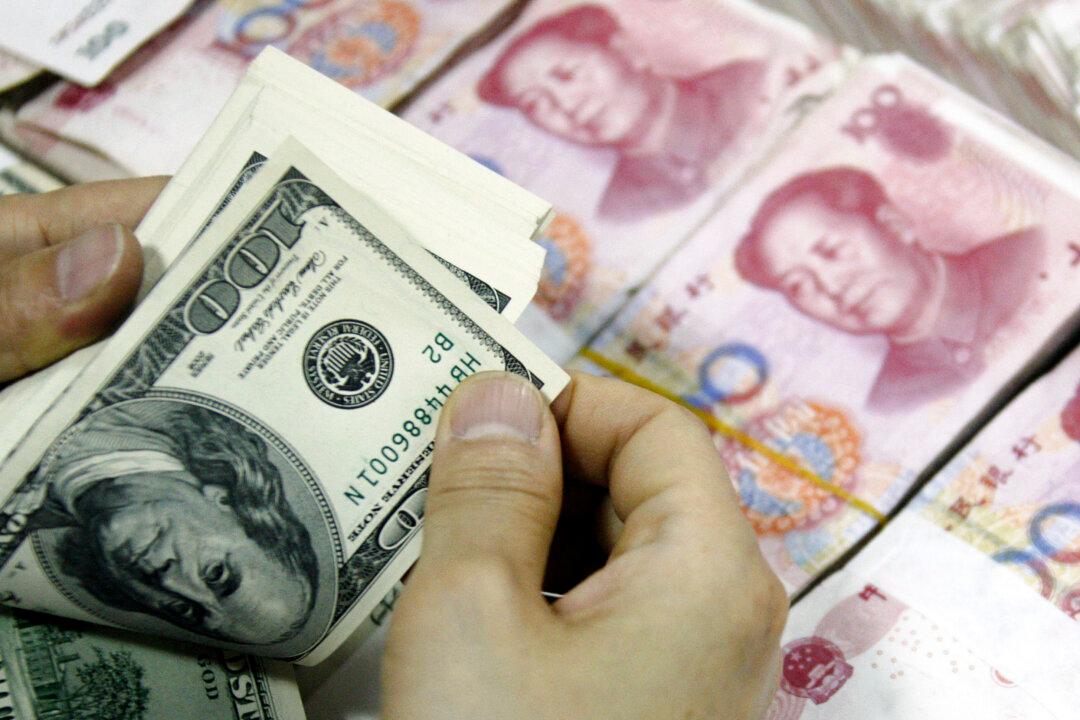The fast depreciation of the Chinese yuan suggests a deliberate attempt by Beijing to partially offset the impact of tariffs, according to China analysts and economists.
On April 8, China’s central bank, the People’s Bank of China, set the yuan’s central parity rate at 7.2038, marking the first time since September 2023 that the rate has surpassed the 7.20 threshold.
This came after President Donald Trump announced cumulative tariffs on Chinese products would increase to 125 percent, which followed the CCP’s latest tariff hike, raising duties on U.S. goods to 84 percent.
Trump has criticised Beijing for manipulating the Chinese yuan, and Treasury Secretary Scott Bessent—who warned the regime against using depreciation to retaliate against American tariff hikes—stated that such actions would lead to further escalation.
Analysts: CCP to Use Depreciation to Offset Tariffs
The sharp decline suggests Beijing is deliberately trying to offset tariffs, say Frank Qin, a senior political and economic analyst.
“In the past, the People’s Bank of China—the central bank under the CCP—would set a daily trading band of plus or minus 2 percent, within which the yuan’s exchange rate could fluctuate. If the rate approached or broke through a key psychological threshold, the central bank would typically intervene,” he told The Epoch Times. “However, this time, we’ve seen no such intervention throughout the process, which clearly indicates that the authorities are deliberately allowing the currency to depreciate.”
Qin highlighted the CCP’s use of devaluation during the last U.S.-China trade war.
“During the U.S.-China trade war from 2018 to 2020, the [yuan] depreciated by over 12 percent,” he said. “Therefore, they may adopt a similar strategy this time. In this context, the warnings issued by President Trump and Treasury Secretary Mnuchin are quite reasonable.”
Nonetheless, Qin believes that the CCP will find it hard this time to respond to the heavy tariffs imposed by Washington and the rest of the world through a significant devaluation.
“On one hand, the tariffs are simply too high. As of Wednesday [April 9] afternoon, we saw that the United States had increased them to 125 percent. Therefore, unless the [yuan] depreciates by several times over, it won’t be able to offset the impact,” he said.
“Furthermore, a sharp devaluation would lead to a substantial outflow of foreign exchange. Under these circumstances, the situation is very unfavorable for the CCP. It could also trigger other countries to impose even higher tariffs on China or erect additional trade barriers in response to the CCP’s using currency devaluation as a means to dump goods on a large scale.
“As a result, the idea that the CCP can once again rely on [yuan] devaluation to escape this challenge is almost impossible.”Frank Tian Xie, a John M. Olin Palmetto chair professor in business at the University of South Carolina Aiken, agreed that Beijing may continue to expand the scope and extent of the devaluation, but if the depreciation is aimed at stimulating exports, its effectiveness will be limited.
“What we’re seeing now is a tariff rate as high as 145 percent, so in order to offset the effect of the tariffs even partially, the currency would need to depreciate significantly—not just by 10 or 20 percent, but possibly by 40, 50 percent, or even more,” he told The Epoch Times.
However, Xie holds that a large-scale devaluation comes at a significant cost for the CCP.
“Because devaluation would greatly increase the cost of imports,” he said. “As we know, China still relies heavily on imports from the United States, such as medical equipment, chips, and various energy products from abroad—all of which require foreign exchange. If [the yuan] depreciates too much, the rising costs of these imports would also become a burden for it.”
“Therefore, I believe the extent of the devaluation will remain limited—unless the [yuan] experiences a complete collapse, a total breakdown of the exchange rate. [Otherwise,] the devaluation won’t be enough to offset the impact of the tariffs. But I do believe they will carry out some level of devaluation.”
Other Ways to Offset Tariffs
The professor pointed out that other than depreciation, the CCP may look for alternative ways to offset the impact of U.S. tariffs, such as creating distractions.
“The CCP might resort to actions like attacking or harassing Taiwan, or more forcefully and explicitly supporting Iran or the Russia-Ukraine war—using these tactics as leverage to pressure the United States into easing economic measures or lowering tariffs,” he said.
“In other words, it may try to offset the impact of tariffs through non-economic, non-tariff means.”

Depreciation May Trigger Foreign Capital Exodus
The strategy Beijing currently adopts is using limited U.S. dollar reserves to keep the USD-yuan exchange rate from spiraling out of control, while tightening capital account controls to delay structural collapse, David Huang, a U.S.-based economic researcher and commentator, told The Epoch Times.
“In the current environment, if the yuan falls below the 7.40–7.45 range, it will trigger a large-scale outflow of risk-averse capital, putting pressure on the Hong Kong dollar linked exchange rate system, causing sharp fluctuations in the offshore yuan liquidity cost (CNH HIBOR), and ultimately leading to a comprehensive revaluation of Chinese dollar-denominated bond market,” he said.
Huang analyzed four major risk chains that will be triggered by a loss of yuan exchange rate control:First, if the yuan exchange rate falls below a critical threshold (such as 7.45), repayment costs for dollar-denominated debt will surge, with an estimated $900 billion in outstanding corporate external debt. Panic selling of state-owned enterprise and major property developer bonds may cause credit default swap spreads to spike sharply, triggering broad credit market stress.
Next, large-scale outflows of foreign direct investment may trigger balance sheet contractions among foreign companies in China, leading to layoffs, factory shutdowns, and relocation of regional headquarters.
Third, simultaneous declines in both equities and currency may trigger panic selling in Hong Kong stocks and H-shares. Foreign investors may rapidly unwind mainland A-share holdings via the Stock Connect program.
Finally, loss of confidence in the yuan as a “stable currency” could undermine its internationalization. Its current share of global payments—just 2.7 percent—may decline further as central banks and corporations turn away from using the yuan.






